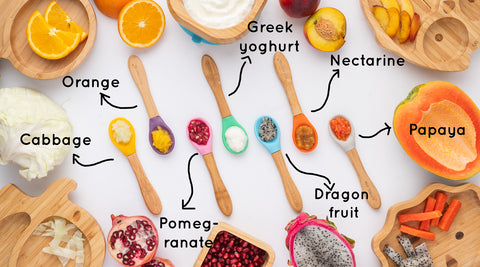Congratulations! You’re nearing the end of an exciting culinary journey with your little one. The final 20 foods in the "100 Foods Before One" series are here. Let's explore these foods and how to safely introduce them.
The idea of this series is to broaden your child's palate and ensure you give them a wide variety of foods, tastes and textures.
It's well worth keeping track on whether or not your child enjoys the individual food or combination and to revisit the food that isn't enjoyed regularly as taste buds are ever changing at this age!

-
Cow's Milk: While cow's milk as a drink is recommended after one year, you can use it in cooking or small amounts mixed with other foods. It's rich in calcium and vitamin D, essential for bone growth.
-
Prawn: A great source of protein and omega-3 fatty acids, prawns should be cooked thoroughly and introduced cautiously to monitor for shellfish allergies.
-
Fish: Opt for mild, low-mercury options like cod or salmon. Fish provides essential omega-3 fatty acids, crucial for brain development.
-
White Beans: Packed with protein, fibre, and iron, white beans can be mashed or pureed for easier digestion.
-
Dragon Fruit: This exotic fruit offers a fun texture and is high in vitamin C and antioxidants. Serve it in small, manageable pieces.
-
Flax Seeds: Rich in omega-3s and fibre, ground flax seeds can be sprinkled over yogurt or mixed into purees.
-
Cabbage: Cooked cabbage is easier for babies to digest and is full of vitamins K and C. It can be steamed or sautéed until soft.
-
Greek Yoghurt: This protein-rich food also contains probiotics, which are beneficial for gut health. Choose plain, full-fat varieties without added sugars.
-
Buckwheat: A nutritious grain alternative, buckwheat can be served as porridge or added to casseroles. It’s gluten-free and high in fibre.
-
Papaya: This tropical fruit aids digestion and is rich in vitamins A and C. Ensure it’s ripe and soft, then serve in small pieces.
-
Raisins: These small, dried fruits are a good source of iron and fibre. Soak them in water to soften and chop into small pieces to prevent choking.
-
Mozzarella: A mild cheese that’s high in calcium and protein. Serve in small, bite-sized pieces.
-
Crumpet: This soft bread can be an excellent vehicle for spreads like peanut butter. Ensure it’s well-toasted and cut into manageable pieces.
-
Peanut Butter: A fantastic source of healthy fats and protein. Introduce individually and monitor for peanut allergies.
-
Orange: Offer in small, seedless segments. Oranges are rich in vitamin C, supporting the immune system.
-
Nectarines: Sweet and juicy, nectarines are high in vitamins A and C. Serve them peeled and cut into small pieces.
-
Spaghetti: Soft and easy to chew, spaghetti can be served with a variety of sauces. Opt for whole grain varieties for added fibre.
-
Brown Rice: A nutritious staple, brown rice is high in fibre and can be served as a base for many dishes. Ensure it’s well-cooked and soft.
-
Polenta: This cornmeal dish can be served soft and creamy, providing a new texture for your baby to explore. It's gluten-free and versatile.
-
Pomegranate: Packed with antioxidants, pomegranate seeds should be offered in small amounts and closely monitored to avoid choking.
Tips for Introducing Complex Foods
- Allergy Watch: Some foods are more common allergens than others. If you have allergy concerns or a food is in the list of high allergens, monitor your child closely and try to only introduce one high allergen food at a time.
- Texture and Size: Ensure foods are soft and cut into small, manageable pieces to prevent choking. Always monitor children whilst they are eating and making adjustments to their food if you feel that they are not able to manage it.
- Balanced Diet: Try to make a baby's diet as varied as possible. Eat the rainbow during a day.
- Encourage Exploration: Allow your baby to explore different textures and flavours at their own pace, making mealtime a fun and stress-free experience.
These last 20 foods introduce a new level of complexity to your baby's diet, helping to develop their palate and ensure they receive a wide range of nutrients.



